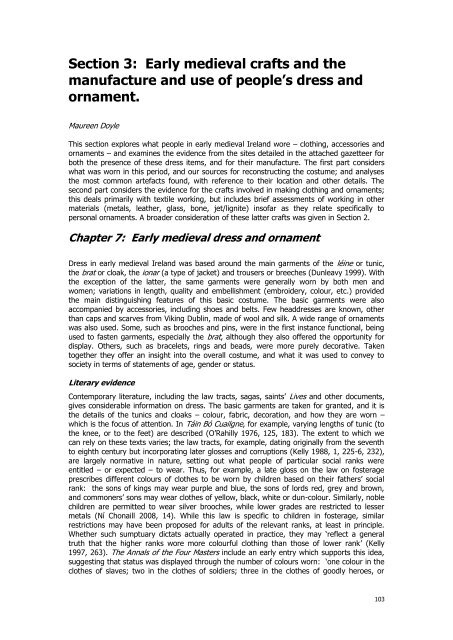EMAP_2012_Report_6_1.pdf (7.3 MB) - The Heritage Council
EMAP_2012_Report_6_1.pdf (7.3 MB) - The Heritage Council
EMAP_2012_Report_6_1.pdf (7.3 MB) - The Heritage Council
Create successful ePaper yourself
Turn your PDF publications into a flip-book with our unique Google optimized e-Paper software.
Section 3: Early medieval crafts and the<br />
manufacture and use of people’s dress and<br />
ornament.<br />
Maureen Doyle<br />
This section explores what people in early medieval Ireland wore – clothing, accessories and<br />
ornaments – and examines the evidence from the sites detailed in the attached gazetteer for<br />
both the presence of these dress items, and for their manufacture. <strong>The</strong> first part considers<br />
what was worn in this period, and our sources for reconstructing the costume; and analyses<br />
the most common artefacts found, with reference to their location and other details. <strong>The</strong><br />
second part considers the evidence for the crafts involved in making clothing and ornaments;<br />
this deals primarily with textile working, but includes brief assessments of working in other<br />
materials (metals, leather, glass, bone, jet/lignite) insofar as they relate specifically to<br />
personal ornaments. A broader consideration of these latter crafts was given in Section 2.<br />
Chapter 7: Early medieval dress and ornament<br />
Dress in early medieval Ireland was based around the main garments of the léine or tunic,<br />
the brat or cloak, the ionar (a type of jacket) and trousers or breeches (Dunleavy 1999). With<br />
the exception of the latter, the same garments were generally worn by both men and<br />
women; variations in length, quality and embellishment (embroidery, colour, etc.) provided<br />
the main distinguishing features of this basic costume. <strong>The</strong> basic garments were also<br />
accompanied by accessories, including shoes and belts. Few headdresses are known, other<br />
than caps and scarves from Viking Dublin, made of wool and silk. A wide range of ornaments<br />
was also used. Some, such as brooches and pins, were in the first instance functional, being<br />
used to fasten garments, especially the brat, although they also offered the opportunity for<br />
display. Others, such as bracelets, rings and beads, were more purely decorative. Taken<br />
together they offer an insight into the overall costume, and what it was used to convey to<br />
society in terms of statements of age, gender or status.<br />
Literary evidence<br />
Contemporary literature, including the law tracts, sagas, saints’ Lives and other documents,<br />
gives considerable information on dress. <strong>The</strong> basic garments are taken for granted, and it is<br />
the details of the tunics and cloaks – colour, fabric, decoration, and how they are worn –<br />
which is the focus of attention. In Táin Bó Cuailgne, for example, varying lengths of tunic (to<br />
the knee, or to the feet) are described (O’Rahilly 1976, 125, 183). <strong>The</strong> extent to which we<br />
can rely on these texts varies; the law tracts, for example, dating originally from the seventh<br />
to eighth century but incorporating later glosses and corruptions (Kelly 1988, 1, 225-6, 232),<br />
are largely normative in nature, setting out what people of particular social ranks were<br />
entitled – or expected – to wear. Thus, for example, a late gloss on the law on fosterage<br />
prescribes different colours of clothes to be worn by children based on their fathers’ social<br />
rank: the sons of kings may wear purple and blue, the sons of lords red, grey and brown,<br />
and commoners’ sons may wear clothes of yellow, black, white or dun-colour. Similarly, noble<br />
children are permitted to wear silver brooches, while lower grades are restricted to lesser<br />
metals (Ní Chonaill 2008, 14). While this law is specific to children in fosterage, similar<br />
restrictions may have been proposed for adults of the relevant ranks, at least in principle.<br />
Whether such sumptuary dictats actually operated in practice, they may ‘reflect a general<br />
truth that the higher ranks wore more colourful clothing than those of lower rank’ (Kelly<br />
1997, 263). <strong>The</strong> Annals of the Four Masters include an early entry which supports this idea,<br />
suggesting that status was displayed through the number of colours worn: ‘one colour in the<br />
clothes of slaves; two in the clothes of soldiers; three in the clothes of goodly heroes, or<br />
103
















